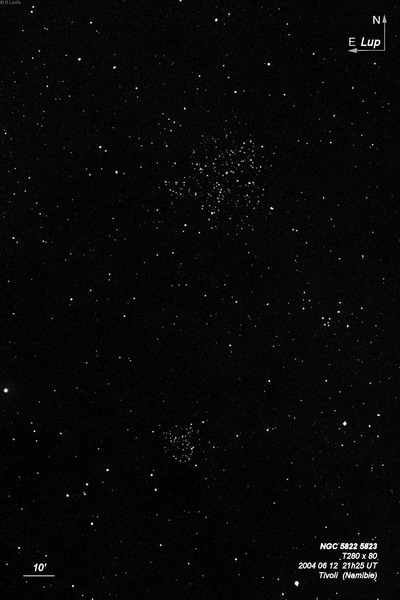
John Herschel discovered NGC 5822 = h3588 on 3 Jul 1836 and recorded "cluster, vL, coarse, but rich and fine; diam in RA = 2 field in PD 25 (30' and 45'); stars 9, 10, 11, 12. General middle taken." His position, though, is on the east side of the cluster. Megastar's position (following NGC 5823) is erroneous.
It seems surprising that James Dunlop (and Nicolas-Louis de Lacaille) missed this bright cluster. But perhaps he didn't. Glen Cozens reported a list of copying errors that Dunlop made between his notes and his published catalog. In the case of Dunlop 357, he reported an RA of 14h 15m, but his handwritten notes show the RA is 14h 50m (for 1827). This corrected RA lands on the west side of NGC 5822 and his description fits very well: "a very extensive cluster stars of mixed small magnitudes; the stars appear to be either congregating together in different parts of the cluster, or breaking up; there are several groups already formed, the whole cluster is composed of lines of stars, but no general attraction towards any particular point."
200/250mm - 8" (7/13/91 - Southern Baja): roughly 60 stars mag 9-12 resolved at 63x. Very large, 40' diameter, almost fills the low power field, elongated ~NW-SE. Spread out with no central condensation. Many stars have similar magnitudes. The stars forming the borders are arranged in rows and arcs with many empty gaps inside this outline. There is an extension of stars to the south.
400/500mm - 18" (7/10/05 - Magellan Observatory, Australia): excellent open cluster at 76x (27 Panoptic). Appears very large, fairly rich, with the main body extended ~WNW-ESE and with dimensions ~40'x25' with roughly 150 stars resolved. The stars are fairly uniform in brightness (many mag 11 and 12) and convincingly arranged in loops and chains surrounded by voids. The outline is quite irregular but well defined by the star chains around the periphery. One chain detaches from the main group near the center and heads south and the outline tapers at the following end. Easy in 10x30 IS binoculars, 7° NE of Alpha Centauri.
Notes by Steve Gottlieb